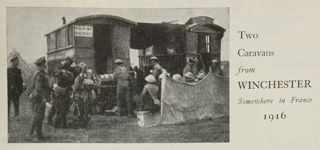
Recruiting on the Road
21 January 2022
On the outbreak of the First World War in 1914, the fledgling motor vehicle came into great demand for war work on both the home front and the front line. Discover the unusual role of the motor caravan in wartime and an unexpected connection with Beaulieu.
In August 1914, as Britain entered the devastating conflict of the First World War, there was an immediate demand for new recruits to the Army and Navy. It wasn’t until two years later that conscription came into being, so before then, all men who joined up did so voluntarily. The drive for volunteers was made through propaganda including the famous poster featuring the face of Lord Kitchener and the slogan ‘Your Country Needs You’, and also through public meetings and by rousing speeches. Men flocked to recruitment offices around Britain, proud to serve their country and excited by the prospect of war in a time before the true realities and horrors were known. Over a million quickly joined up, but the drive for volunteers increased as the war raged on.
One challenge faced in a world before widespread telecommunications, was how to reach and persuade potential recruits in rural and isolated parts of the country. Following in the footsteps of missionary and suffrage caravans which were used to successfully spread their message before the war, some motor caravans (now known as ‘motorhomes’) took on a new role.
Motor caravans had been gradually appearing on British roads from the early twentieth century, but they were expensive, noisy and cumbersome and therefore had not truly rivalled their lighter horse-drawn counterparts. Yet a growing number of Club members owned such vehicles, including Mr Alan Macdonald, an Artist from Chelsea who had been closely involved with the organisation in its founding years. On the outbreak of war Mr Macdonald offered his motor caravan to the War Office, who in turn made him the Recruiting Officer in charge of the vehicle. In 1915 Macdonald toured Huntingdonshire, Bedfordshire and Hertfordshire in search of recruits to the forces. He was successful in signing up a considerable number of men using his unconventional vehicle.

That same year in Winchester, Hampshire, the thriving pre-war horse-drawn caravan builder and hire company ‘Hutchings of Winchester’ was coming to terms with its main means of business being halted by the conflict. Its owner Bertram Hutchings was unable to serve due to a disability, and after his horses were requisitioned by the Government he took the decision to donate his entire hire fleet of horse-drawn caravans for use in the field including as mobile First Aid units.
Fellow Caravan Club member, Engineer and Royal Naval Commander Charles Eldred, went to Hutchings in 1915 with a special commission – a motor caravan to be used by the Royal Naval Division for recruitment. With a Hutchings body built on an earlier 20 horsepower Darraq chassis, the motor caravan was more compact, lightweight and practical than many of its predecessors. Designed with a folding desk so that it could operate as an office during the day, by night, a bunk accommodated the Recruiting Officer and the Petty Officer driver. Named the ‘Vanguard’, the motor caravan began travelling through South Hampshire to encourage men between the age of 18 and 38 to sign up to serve in the Navy, changing any preconceptions that prior sea experience would be required.

Recently, an article was discovered in The Car Illustrated, a historic journal held in the National Motor Museum’s Reference Library, which details the Vanguard and the tours it took. Incredibly, during a 1915 recruitment drive of New Forest villages it made a stop at Beaulieu and was pictured halted by the Clock House adjacent to Palace House.
For established caravan builders like Bertram Hutchings, the recruiting van may have seemed like an area to develop further in support of the war effort, but from May 1916 an act was passed for all able men between the age of 18 and 41 to be conscripted into the forces, with the need for active recruitment ending.
For Hutchings, the motor caravan which he built for the Royal Naval Division was the start of more experimentation with the merging of caravan bodies onto motorised chassis, and after the war he developed several for the purpose of leisure. However, the widespread popularity of the motor caravan was not to take off at this time. Taxation changes meant that owners had to pay the same price for a motor caravan as a commercial vehicle, causing the popularity of the trailer caravan towed by the motor car to dominate for decades to come.


Subscribe for updates
Get our latest news and events straight to your inbox.